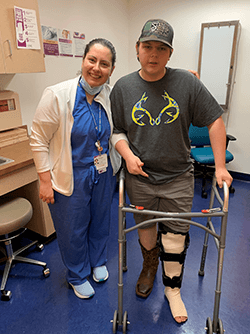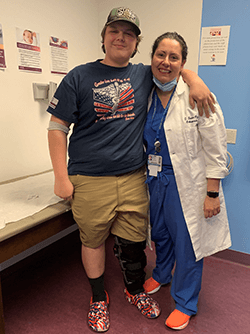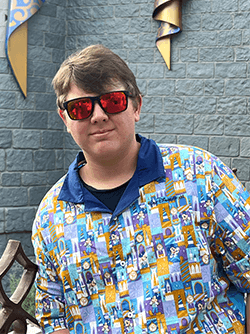Corey Scheetz, a West Virginia native and soon to be high school graduate, recalls a bad day several years ago that led him to UPMC Children’s Hospital of Pittsburgh.
On April 16, 2020, Corey was in a dirt bike accident that resulted in a severe fracture to his leg.
He was brought to the nearest Emergency Department (ED) in West Virginia, but once there, doctors there decided that it wasn’t the best place to properly treat Corey’s injury. Among the options recommended to them was UPMC Children’s Hospital, equipped with a Level I (highest level) Regional Resource Pediatric Trauma Center where orthopaedic trauma professionals are always available in the ED to treat complex orthopaedic trauma injuries that come in.
“I had surgery on my skull at [UPMC] Children’s back when I was a baby, and we had a great experience. So my parents have always been advocates of Children’s,” says Corey.
Incidentally, Corey had actually been at Children’s the very day before his accident for an outpatient procedure to remove a cyst. So the Scheetzes were very familiar with the Hospital and the quality of care they would receive there, making their decision of where to transfer Corey for further care a relatively easy one. He transferred via ambulance to the UPMC Children’s ED where the family was met by Z. Deniz Olgun, MD, a double-fellowship trained orthopaedic surgeon and director of the Pediatric Orthopaedic Trauma Program at Children’s.
A Complicating Factor

When Corey arrived, his leg was extremely swollen and painful, even more than would be typical of a traumatic injury like his. He was diagnosed acute compartment syndrome, a rare condition that occurs when pressure within the muscles builds to dangerous levels. This pressure can decrease blood flow, which prevents nourishment and oxygen from reaching nerve and muscle cells. The acute form of compartment syndrome can be caused by a severe injury like Corey’s and unless the pressure is relieved quickly via surgical intervention, permanent disability and tissue death may result.
Corey was quickly taken into surgery where Dr. Olgun temporized his fracture with an external fixator to address the immediate concern of the extreme swelling due to the compartment syndrome. Corey’s leg remained open while they waited for the pressure to be relieved and the swelling to subside. Once it was at a manageable level, Dr. Olgun and her team were able to complete the reconstruction of his tibia and close his leg.
A Different Cause for Concern

Once Corey’s leg was closed up after repairing his leg bone, that should have meant that he entered into a rehabilitation phase and that the worst was behind him.
Unfortunately, the break in the bone had been fixed, but Corey ended up with an infection at the injury site. The infection was persistent and he would clear it, and then weeks later, he wouldn’t be able to clear it on his own and it would require further surgery and reopening of the site to address.
“With an injury like Corey’s, it is very common to get an infection,” says Dr. Olgun. “Orthopaedic infections are also very difficult to treat and aggressive management of the infection is essential in preserving limb and function.”
All in all, Corey says that he ended up needing 22 surgeries including two skin grafts and three blood transfusions over the course of six months following his initial injury and surgery.
Michael Bykowski, MD, pediatric plastic surgeon at Children’s, was brought on to Corey’s case to perform a muscle flap that is a surgical procedure that is commonly used to eradicate infection and to revascularize bone. It then provides a surface for skin grafts, which Corey ended up needing as well.
According to Corey, a lot of that time period is a blur. But he says that given the circumstances, it was “the best place he could’ve been.”
“I absolutely love Children’s. Everybody there was amazing to me. They all seemed like they actually cared about you,” says Corey.
After a lengthy bout in the hospital, doctors were finally able to clear Corey’s infection once and for all. “Because of how difficult these orthopaedic infections are to treat, it is a big accomplishment that now, two years out from his injury, Corey is infection-free without taking antibiotics anymore and he has almost normal function and has needed no further surgeries,” says Dr. Olgun.
The Final Step in the Road to Recovery
Once Corey cleared the infection, he then began the part of his recovery process: Rehabilitation of his leg.
While at Children’s, he began a little bit of physical therapy and, once released from the hospital, he continued a vigorous schedule of physical therapy near his home in West Virginia. Three times per week, he was meeting with his physical therapist, Shawn, for four hours at a time to rebuild strength in his leg and improve his mobility.

“Rehab was really tough. I was essentially trying to relearn how to walk at 16, 17 years old. I had to completely restart,” says Corey. “I came home using a walker, then transitioned to crutches, then to a cane. My one leg was completely useless. I would fall down a lot. But my physical therapists are the reason I got better. They motivated me and helped me eventually get back to where I am now.”
Today, Corey says he is “basically back to normal” with a few exceptions.
“I can run, just not as fast as before. I work out and do exercises specifically to maintain function of that leg. But I am on my feet a lot for my job – I’m only sitting for about 40 minutes in an 8 hour work day and I get around well,” says Corey.
After he graduates in May, Corey plans to go to trade school to become a machinist.
“My experience with Children’s was great. All of the nurses, everybody was truly amazing. I’ll definitely be back at Children’s if anything else ever happens,” said Corey.
We hope for Corey’s sake that he doesn’t need Children’s again, but we are here if he ever does.
Corey’s treatment and results may not be representative of similar cases.









